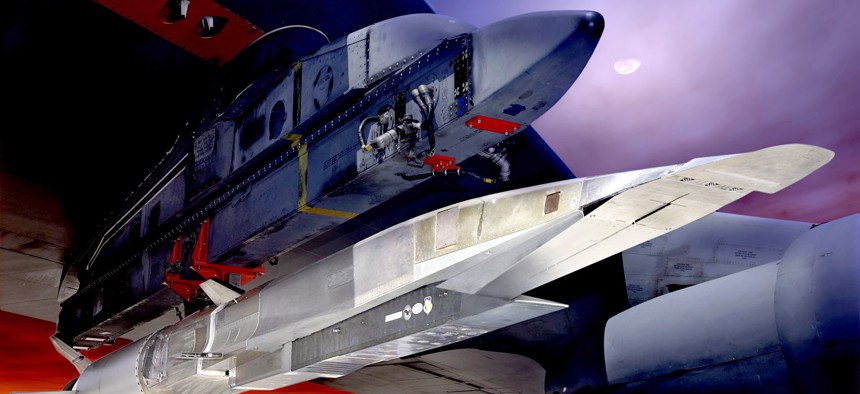
The X-51A Waverider is an unmanned, autonomous supersonic combustion ramjet-powered hypersonic flight test demonstrator US AIR FORCE
What’s Next in US Hypersonic Efforts as Air Force Shelves ARRW
The service will focus on a potentially cheap scramjet as research continues in other services.
The Air Force is shelving its effort to make a boost-glide missile after an unsuccessful test, but will press on with a scramjet-powered hypersonic weapon, the service’s acquisition chief said Thursday.
The service “does not currently intend to pursue follow-on procurement of the ARRW”—Air-Launched Rapid Response Weapon—“once the prototyping program concludes,” Air Force acquisition head Andrew Hunter said in testimony on Thursday.
The cancellation did not surprise Mark Lewis, who used to run the Pentagon’s hypersonics efforts.
“People underestimated how hard it was to take a relatively larger long-range boost-glide system and shrink it down to a tactical system that's small enough” to fit “under the wing of an airplane,” said Lewis, now executive director of the National Defense Industrial Association’s Emerging Technologies Institute.
While it might seem like it would be easy to take a missile system and just shrink it down, at hypersonic speeds—five times faster than sound—the technical challenges become greater.
“When you get smaller, it becomes ever more difficult, for example, to balance the trade between aerodynamic drag—the resistance on it as it's going through the atmosphere—and the heating rate. Because [when] you get smaller, you get sharper, you get hotter,” he said.
The R&D effort shouldn’t be reckoned a failure just because it didn’t produce a production missile, he said: “We should be doing risky things.”
Overall, Lewis said, U.S. hypersonics research, which is progressing in multiple services, is on a good course.
On Thursday, Army Chief of Staff Gen. James McConville told lawmakers that the Army expects to field a viable hypersonic weapon this year.
Lewis said the Air Force, meanwhile, can now focus on a far more practical and important goal: the scramjet-powered Hypersonic Attack Cruise Missile, or HACM, program.
A scramjet missile will likely cost less than other hypersonic-missile efforts, said Lewis. The technology for a hypersonic air-breathing weapon has been around since 2002, so it’s less of a technical push than an air-launched boost-glide weapon. The Air Force ended its previous scramjet missile program in 2012, which Lewis called a huge mistake.
The U.S. now finds itself playing catch-up to China and Russia—the latter of which has used its missiles to dramatic effect in Ukraine.
“One of the Ukrainian defense officials conceded that they had a very good defense against conventional missile missiles,” Sen. Angus King, I-Maine, told reporters after a recent trip to Ukraine. “Their air defense system is very effective. But not anywhere near as effective against the hypersonic missiles that the Russians deployed.”
King said the arrival of operational hypersonic missiles has caught lawmakers’ interest. King likened them to the use of the longbow at the battle of Agincourt.
“When you look at technology affecting drastically the course of conflict, hypersonics fall into that category,” he said.
U.S. military leaders have made a top priority of developing hypersonic weapons and defenses against them. The Pentagon’s 2024 budget proposal, sent to Congress in mid-March, requests $11 billion “to deliver a mix of hypersonic and long-range subsonic missiles to hold key targets at risk and enable future warfighting concepts.”
The budget calls for the military to “deliver initial all-domain hypersonic capability” over the next five years and touts 12 “successful tests” conducted last year. The money in the budget would buy 24 hypersonic missiles in 2024 and “enhance air-launched hypersonic prototyping and testing.”
King said that he was “encouraged” by the $11 billion investment in hypersonics research in the Pentagon’s budget request and the President’s March 3 order on using the Defense Production Act to accelerate the nation’s industrial base for hypersonics.
Among the remaining obstacles, Lewis said, is the need for test ranges and facilities, which are now being built.
Another is persuading industry to get on board.
“Until the services say, ‘Hey, we're gonna buy, not 10, not 20, but 100 or 1000 of this thing,’ it’s not going to do what we wanted to do,” he said.
And there are other supply issues that the Pentagon needs to pursue at the same time it’s pursuing research and development, said Lewis.
“Hypersonic systems require the production of high-temperature materials. So you'd have to be producing high-temperature materials for aerospace applications at a rate that, frankly, is far beyond where we've been previously. It will require investment.”
Canceling ARRW is a blow to Lockheed Martin, but the exact impact on the company’s bottom line is unknown because the Pentagon does not disclose detailed information about projected purchases of hypersonic weapons.
Still, on recent quarterly earnings calls, Lockheed executives have touted several development programs that were expected to begin production in 2024.
Marcus Weisgerber contributed to this report.


